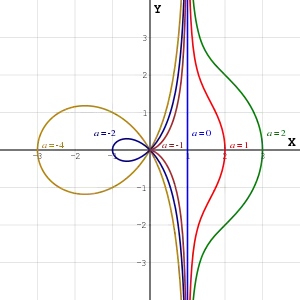
The Conchoid of de Sluze for several values of a
In algebraic geometry, the conchoids of de Sluze are a family of plane curves studied in 1662 by Walloon mathematician René François Walter, baron de Sluze.[1][2]
The curves are defined by the polar equation
In cartesian coordinates, the curves satisfy the implicit equation
except that for a = 0 the implicit form has an acnode (0,0) not present in polar form.
They are rational, circular, cubic plane curves.
These expressions have an asymptote x = 1 (for a ≠ 0). The point most distant from the asymptote is (1 + a, 0). (0,0) is a crunode for a < −1.
The area between the curve and the asymptote is, for a ≥ −1,
while for a < −1, the area is
If a < −1, the curve will have a loop. The area of the loop is
Four of the family have names of their own:
- a = 0, line (asymptote to the rest of the family)
- a = −1, cissoid of Diocles
- a = −2, right strophoid
- a = −4, trisectrix of Maclaurin
References
- ↑ Smith, David Eugene (1958), History of Mathematics, Volume 2, Courier Dover Publications, p. 327, ISBN 9780486204307.
- ↑ "Conchoid of de Sluze by J. Dziok et al.on Computers and Mathematics with Applications 61 (2011) 2605–2613" (PDF).
This article is issued from Wikipedia. The text is licensed under Creative Commons - Attribution - Sharealike. Additional terms may apply for the media files.